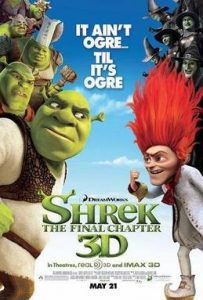
(Sight & Sound, BFI)
Shrek Forever After is the fourth, and apparently final, computer-animated film to feature the grumpy green ogre who’s been the unofficial mascot of the Dreamworks studio since the first Shrek nine years ago. The original divided animation fans; some saw it as an instant classic, others an abomination (French animator Michel Ocelot declared, “I cannot watch it! I suffer because of the ugliness”). This writer found it an enjoyable if synthetic respray of a Disney-spoofing mentality going back through The Simpsons to the far more spontaneous Hollywood cartoons by Bob Clampett and Tex Avery. Shrek 2 (2004) was more of the same, but with an inspired new character, Puss in Boots, voiced by Antonio Banderas. Shrek the Third (2007) was yet more of the same, but with lesser jokes and no worthy additions to the cast. (Neither Justin Timberlake’s prince nor Eric Idle’s wizard return here.)
The fourth film is directed by Mike Mitchell, helming his first animated feature after live-action comedies such as Deuce Bigelow: Male Gigolo (1999), featuring Rob Schneider, and Surviving Christmas (2004), with Ben Affleck. Shrek Forever After, though, reflects the increasing trend of Dreamworks animated films to trust character-driven stories. It was obvious in this year’s How to Train Your Dragon, but it was true even in such joke-name films as Kung Fu Panda (2008) and Monsters vs. Aliens (2009). Shrek Forever After is a soundly-told fantasy adventure, though it will disappoint anyone wanting the belly-laughs of the first Shrek when the fairy-tale princess caused a Disney bluebird to explode.
The sequel takes its premise from the last act of It’s a Wonderful Life (1946), with Shrek making an unwise wish and being swept into a nightmare world in which he was never born and evil rules the land. Shrek Forever After also feels like a semi-remake of Pixar’s superhero animated film, The Incredibles (2004). Both are about middle-aged heroes who rail against domesticity, yearn for their glory days (Shrek wants to scare people again) and get drawn into traps by cunning villains (Rumpelstiltskin, in Shrek’s case). Like The Incredibles, Shrek Forever After starts with some uncomfortably intense scenes of midlife angst. Shrek’s days of domestic “bliss” accelerate manically and a chaotic birthday party triggers his mad-as-hell roar. When he enters the parallel world, the skies are cloudy and dark; he rushes to his tree-stump home to find an empty hollow beneath. Beyond It’s a Wonderful Life, there are echoes of Return to Oz (1985), Disney’s unpopular dark sequel to The Wizard of Oz.
The film does a good job of establishing its adventure-film stakes, with Rumplestiltskin introduced in a menacing white-trash trailer park with a snarling pet goose. The later scenes are more routine, even with Shrek’s ogre squeeze Fiona, voiced by Cameron Diaz, showing up as a Braveheart-style warrior princess. (The nicest moment is when the ogres reconnect emotionally while bashing each other in the face.) The Pied Piper of Hamelin makes for an underwhelming heavy, but the battles in Rumplestiltskin’s castle are lively and well-mounted, especially in 3D. The resolution is disappointingly pat, with everything set back to normal, whereas it would have been good to see Fiona keep some of her warrior traits in the “real” world. (She had some Matrix-style flying martial arts moves in the first film, but the sequel strangely forgets them when she actually becomes a warrior.) In The Incredibles, the superhero family was last shown heading into more adventures at the fade-out. Shrek, in contrast, is last shown where he began nine years ago, wallowing happily in the mud.
